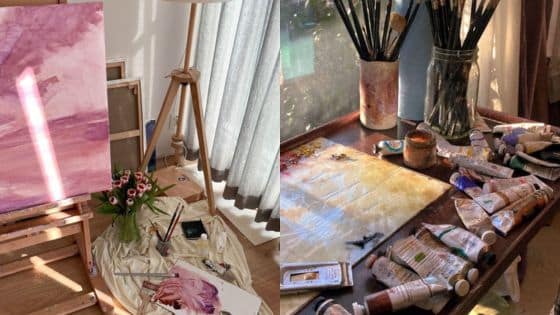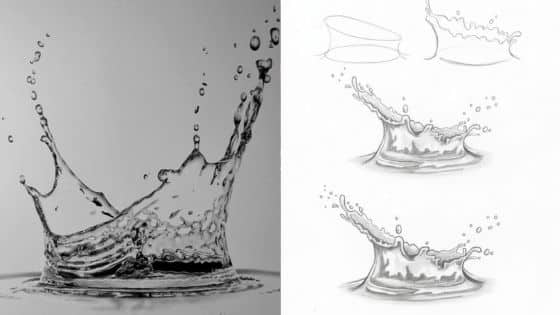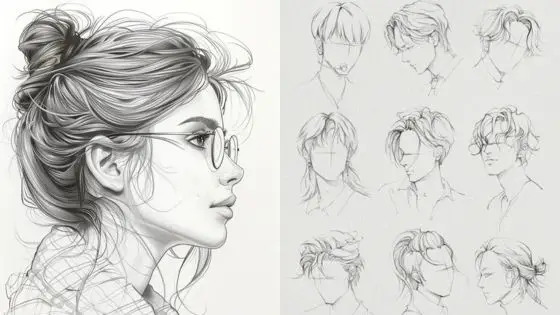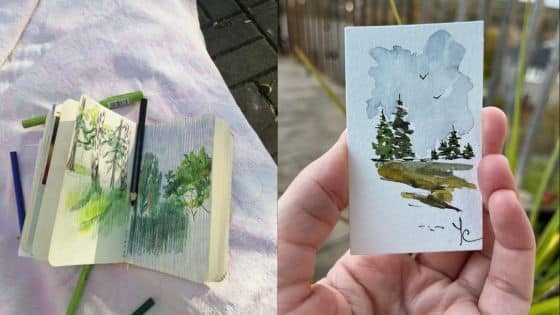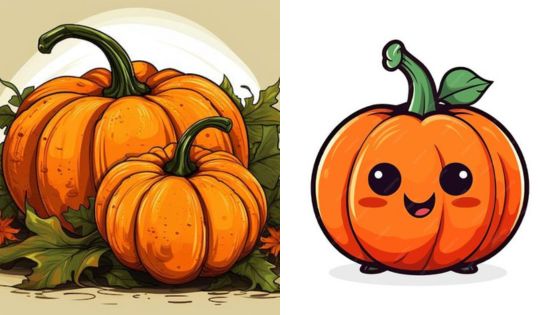Fall presents countless opportunities for artists to explore seasonal themes through drawing. The changing leaves, harvest elements, and cozy atmosphere create perfect subjects for both beginners and experienced artists.
Drawing fall-themed artwork allows you to practice fundamental techniques while capturing the warm colors and textures that define autumn. Pumpkins, leaves, acorns, and woodland creatures offer simple yet engaging subjects that help develop your artistic skills. These seasonal elements provide natural inspiration for creating artwork that reflects the beauty of the season.
Whether you prefer simple sketches or detailed illustrations, fall drawing ideas range from quick doodles to complex compositions. The season’s rich color palette of oranges, reds, yellows, and browns creates visual interest in any artwork. You can explore everything from individual autumn leaves to complete seasonal scenes.
Key Takeaways
- Fall subjects like pumpkins, leaves, and woodland creatures offer excellent practice for artists of all skill levels
- Autumn’s warm color palette provides natural inspiration for creating visually appealing seasonal artwork
- Simple fall elements can be combined into both quick sketches and detailed compositions depending on your artistic goals


Essential Fall Drawing Ideas
These core autumn subjects provide the foundation for seasonal artwork, from simple sketches perfect for beginners to detailed illustrations that capture the essence of fall.
Classic Pumpkin Sketches
Pumpkins serve as the quintessential fall drawing subject. Start with basic oval shapes and add vertical ridges to create realistic texture.
Draw various pumpkin sizes together for visual interest. Small sugar pumpkins work well alongside large jack-o’-lantern varieties.
Basic pumpkin drawing steps:
- Sketch a wide oval shape
- Add curved vertical lines for sections
- Include the stem and small curly vine
- Shade between ridges for depth
Consider drawing pumpkins in different settings. Place them on wooden porches, in wheelbarrows, or scattered across farmland scenes.
Add personality with different expressions if creating jack-o’-lantern faces. Triangle eyes and jagged smiles create classic looks, while more complex expressions add character to your fall artwork.


Autumn Leaves and Foliage
Leaf drawings capture fall’s most recognizable feature. Focus on common shapes like maple, oak, and birch leaves.
Popular leaf types for drawing:
- Maple leaves: Five-pointed with serrated edges
- Oak leaves: Rounded lobes and smooth curves
- Birch leaves: Small, triangular with pointed tips
- Elm leaves: Oval with prominent veining
Practice drawing individual leaves first. Pay attention to vein patterns that run from the stem to the leaf edges.
Create leaf collections by arranging different varieties together. Overlap leaves at various angles to show natural randomness.
Draw falling leaves to add movement to your compositions. Show them at different stages of descent with slight rotation and curved paths.
Use shading techniques to show autumn colors. Even in pencil drawings, you can suggest the warmth of orange, red, and yellow through value changes.
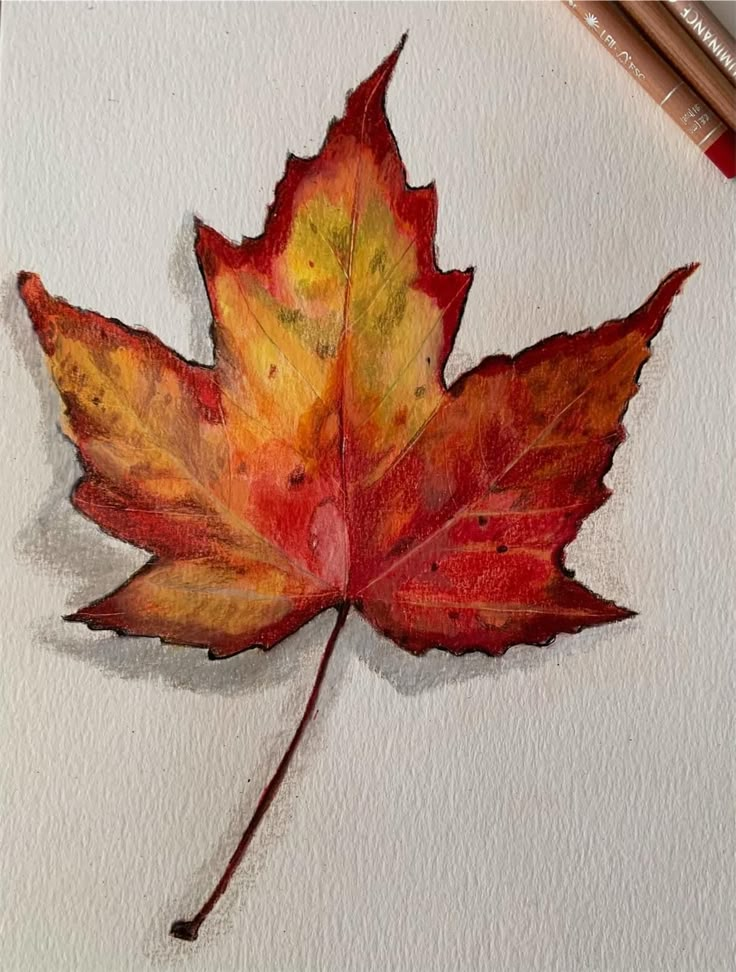
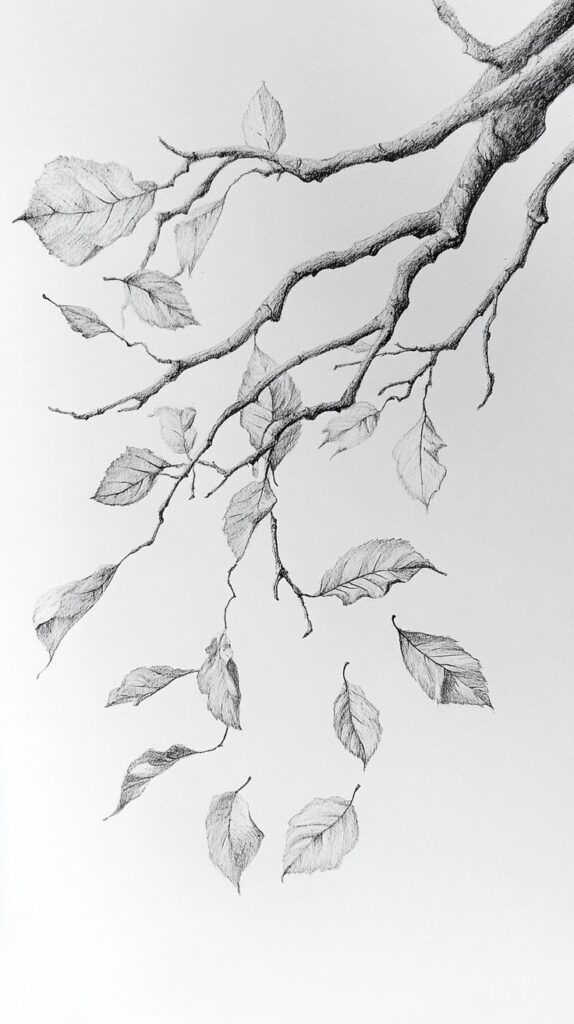
Woodland Animals
Forest creatures make charming subjects for fall drawing ideas. Squirrels, deer, and foxes are particularly popular choices.
Squirrels offer dynamic poses as they gather acorns. Draw them sitting upright, climbing trees, or with cheeks full of nuts.
Key features for woodland animals:
- Squirrels: Bushy tails and alert expressions
- Deer: Graceful necks and large eyes
- Foxes: Pointed ears and fluffy tails
- Raccoons: Masked faces and ringed tails
Focus on simple shapes first. Most animal bodies start with basic ovals and circles before adding details.
Show animals in their natural fall activities. Draw deer among falling leaves or foxes walking through autumn forests.
Add seasonal elements like animals wearing scarves or surrounded by harvest items. These touches enhance the cozy autumn feeling in your artwork.


Acorns, Pinecones, and Natural Elements
These small natural objects add authentic details to fall compositions. They work well as standalone subjects or supporting elements.
Acorns feature two distinct parts: the smooth nut and the textured cap. Draw the cap with crosshatch patterns to show its rough surface.
Pinecones require attention to their overlapping scales. Start with an oval shape and add individual scales working from bottom to top.
Drawing natural elements:
- Acorns: Smooth oval with textured cap
- Pinecones: Layered scales in spiral pattern
- Twigs: Irregular lines with small branch points
- Berries: Small circles in clusters
Combine these elements in still-life arrangements. Group acorns with colorful leaves or scatter pinecones among autumn flowers.
Use these items to fill empty spaces in larger compositions. They add visual weight and authentic seasonal detail to your fall artwork.


Easy Fall Drawing Inspiration
Starting with simple seasonal objects and basic techniques makes fall drawing accessible for artists at any level. These foundational approaches help you build confidence while creating artwork that captures autumn’s cozy atmosphere in your sketchbook.
Simple Fall Objects
Pumpkins offer the perfect starting point for fall drawing practice. Begin with basic oval shapes and add curved vertical lines for natural ridges. Small details like stems and curly tendrils bring pumpkins to life on paper.
Autumn leaves provide endless variety for your sketchbook. Start with maple leaves using simple star shapes, then add serrated edges. Oak leaves use rounded lobes, while birch leaves feature simple oval forms with pointed tips.
Basic Fall Objects to Draw:
- Acorns with textured caps
- Pine cones using overlapping scales
- Mushrooms with spotted caps
- Bare tree branches
- Cozy mittens and scarves
Hot beverages make charming seasonal subjects. Draw steaming mugs using cylinder shapes and add whimsical steam curls. Include details like marshmallows or cinnamon sticks floating on top.
Step-by-Step Fall Scenes
Creating simple landscapes starts with horizon lines and basic shapes. Draw rolling hills using gentle curved lines, then add bare trees with branching patterns that split into smaller divisions.
Scene Building Process:
- Sketch the horizon and ground plane
- Add large background elements like trees or buildings
- Include mid-ground details such as fallen leaves
- Finish with foreground objects like pumpkins or logs
Forest scenes work well with layering techniques. Place larger trees in the background using lighter lines, then add darker, more detailed trees in front. Scatter fallen leaves across the ground using small oval shapes.
Cozy indoor scenes capture fall’s warmth perfectly. Draw simple furniture shapes, add throw blankets with wavy textures, and include seasonal decorations like small pumpkins on tables.
Beginner-Friendly Techniques
Shading basics enhance your fall drawings significantly. Use the side of your pencil for soft shadows under pumpkins and leaves. Cross-hatching works well for tree bark textures and deeper shadows.
Light sources create mood in fall artwork. Position your imaginary light source consistently throughout each drawing. Shadows fall opposite the light direction, while highlights appear on surfaces facing the light.
Essential Techniques:
- Blending with tissue paper for smooth pumpkin surfaces
- Stippling dots for leaf textures and ground cover
- Contour lines following natural curves of objects
- Value scales from light yellows to deep oranges and browns
Texture creation brings fall subjects to life. Use short, choppy strokes for tree bark and circular motions for fluffy clouds. Leaves benefit from following their natural vein patterns with your pencil strokes.
Practice these techniques on separate sketchbook pages before combining them in finished drawings. Start with single objects, then gradually build more complex compositions as your confidence grows.


Cute Fall Drawing Concepts
These charming fall drawing concepts blend seasonal elements with adorable characters, cozy food items, and autumn accessories. The cute approach transforms traditional fall motifs into heartwarming artwork that captures the whimsical side of the season.
Adorable Critters and Characters
Fall animals make perfect subjects for cute fall drawing ideas. Draw woodland creatures like foxes wrapped in tiny scarves or hedgehogs carrying acorns. These characters instantly add charm to your fall artwork.
Cats wearing leaf hats create delightful seasonal illustrations. You can sketch small animals sipping warm drinks from oversized mugs. Add rosy cheeks and sleepy eyes to make them extra endearing.
Consider drawing squirrels gathering nuts or owls perched on pumpkins. Bears in cozy sweaters or rabbits jumping in leaf piles work well too. Each animal can wear miniature autumn clothing like knitted hats or plaid bandanas.
Popular Animal Combinations:
- Foxes with maple leaves
- Owls on tree branches
- Raccoons with pumpkins
- Deer among fallen leaves
Whimsical Autumn Food
Seasonal treats offer endless opportunities for cute drawings. Sketch smiling pumpkins with different facial expressions or draw steaming mugs topped with whipped cream and cinnamon sticks. These food items become characters themselves.
Apple pie slices with tiny faces make charming subjects. Add steam lines rising from hot cocoa mugs to show warmth. Draw candy corn arranged in patterns or create scenes with anthropomorphic acorns having tea parties.
Pumpkin spice lattes with kawaii-style expressions work perfectly for fall artwork. You can illustrate donuts covered in autumn sprinkles or draw tiny ghosts made from marshmallows. Each food item should have simple, friendly features that make viewers smile.
Seasonal Accessories
Autumn accessories add cozy elements to your drawings. Sketch warm scarves flowing in the breeze or draw knitted mittens hanging on clotheslines. These items suggest comfort and seasonal preparation.
Boots splashing through puddles create dynamic scenes. Draw umbrellas decorated with fall patterns or sketch cozy sweaters laid flat with leaf designs. Add details like wooden buttons or cable-knit textures.
Consider illustrating lanterns glowing softly or drawing wreaths made from colorful leaves. Plaid blankets draped over chairs suggest indoor comfort. Each accessory should feel inviting and capture the essence of autumn’s cozy atmosphere.


Fall Drawing Ideas for Your Sketchbook
Themed prompts and cozy composition techniques transform your sketchbook into a seasonal art collection. These structured approaches help you capture autumn’s essence through focused drawing exercises and thoughtful arrangement.
Themed Sketchbook Prompts
Daily fall drawing ideas give your sketchbook purpose and direction. Create a 30-day autumn challenge with specific subjects for each day.
Start with simple prompts like pumpkins, acorns, and maple leaves. Progress to seasonal activities such as apple picking, bonfires, and cozy sweaters.
Nature-focused prompts:
- Tree silhouettes at different times of day
- Close-up leaf textures and patterns
- Woodland creatures preparing for winter
- Fall weather scenes like fog or rain
Lifestyle prompts:
- Steaming coffee mugs with autumn decorations
- Boots and scarves arranged as still life
- Harvest vegetables in baskets
- Indoor scenes with fall candles
Dedicate one page per prompt or combine multiple small sketches. Use the same sketchbook throughout autumn to track your artistic growth.
Creating Cozy Fall Compositions
Composition planning makes your fall drawing ideas more visually appealing. Use the rule of thirds to position focal elements like pumpkins or trees.
Layer elements at different depths. Place large items like trees in the background, medium objects like fence posts in the middle ground, and small details like fallen leaves in the foreground.
Essential composition techniques:
- Overlapping shapes create depth and interest
- Warm color schemes using oranges, reds, and yellows
- Texture contrast between smooth pumpkins and rough bark
- Leading lines from tree branches or pathways
Create borders using autumn motifs. Draw small acorns, leaves, or vines around your main subject to frame the composition naturally.
Group odd numbers of objects together. Three pumpkins or five leaves create more dynamic arrangements than even numbers.
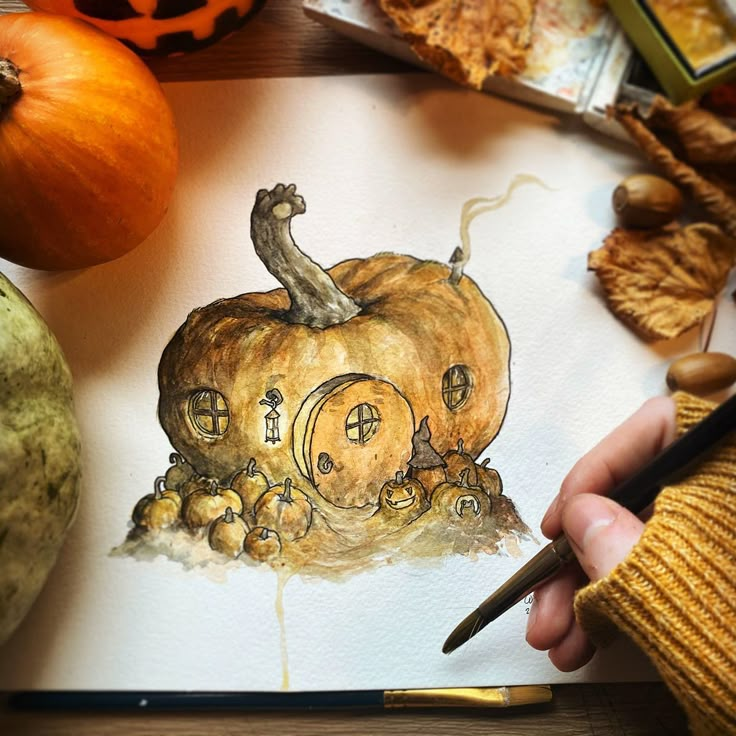

Creative Approaches to Autumn Art
Autumn artwork requires specific color mixing techniques, versatile tool combinations, and distinctive pattern-making methods. These approaches transform simple fall drawing ideas into compelling seasonal art pieces.
Blending Fall Colors
Warm color mixing forms the foundation of effective autumn artwork. Start with primary colors and blend burnt orange, deep red, and golden yellow using gradual transitions.
Layer colors from light to dark for natural depth. Begin with pale yellow highlights, then add orange in the middle tones, and finish with burgundy or brown shadows.
Temperature contrast enhances fall scenes dramatically. Mix warm oranges and reds with cool purples and blues to create visual interest. This combination appears naturally in autumn skies and shadow areas.
Create custom autumn palettes by mixing:
- Cadmium yellow + burnt sienna = rich golden tones
- Alizarin crimson + raw umber = deep burgundy
- Yellow ochre + titanium white = soft cream highlights
Color temperature shifts occur throughout fall compositions. Foreground elements should use warmer tones while background areas benefit from cooler, muted versions of the same colors.
Mixing Drawing Tools and Techniques
Layered media approaches produce rich textures in fall drawing ideas. Combine colored pencils with watercolor washes for leaves, or use pastels over ink drawings for atmospheric effects.
Start with light pencil sketches, then apply watercolor for base colors. Add colored pencil details on top once the paint dries completely.
Texture creation techniques bring autumn elements to life:
| Tool Combination | Best For | Technique |
|---|---|---|
| Charcoal + Blending stump | Tree bark, shadows | Smudge and lift highlights |
| Watercolor + Salt | Leaf textures | Sprinkle salt on wet paint |
| Ink + Colored pencil | Detailed illustrations | Outline first, color second |
Mixed media experimentation opens creative possibilities. Try gouache for opaque areas combined with transparent watercolors for luminous effects in sky areas.
Use masking fluid to preserve light areas when working with wet media. This technique works perfectly for creating bright leaf veins or sunlit grass blades.
Crafting Unique Fall Patterns
Natural pattern inspiration comes directly from autumn’s organic forms. Study actual leaf arrangements, bark textures, and branch structures to develop authentic repeated motifs.
Create seamless patterns by sketching individual elements first. Draw acorns, maple leaves, and pine cones separately, then arrange them in flowing compositions.
Geometric interpretations of fall elements offer modern approaches to traditional subjects. Transform leaf shapes into angular designs or create tessellated pumpkin patterns.
Scale variation adds visual rhythm to pattern work. Mix large focal elements like prominent leaves with smaller supporting details such as berries or twigs.
Overlapping techniques create depth within pattern designs. Layer transparent autumn leaves at different angles, allowing underlying shapes to show through partially.
Use negative space effectively by incorporating the background as part of your pattern design. White or cream spaces between fall elements can represent morning mist or filtered sunlight.
- 0shares
- Facebook0
- Pinterest0
- Twitter0
- Reddit0








